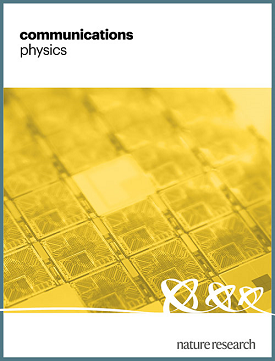增强基于量子点的基塔耶夫链的激发间隙
IF 5.4
1区 物理与天体物理
Q1 PHYSICS, MULTIDISCIPLINARY
引用次数: 0
摘要
通过半导体-超导体混合段连接双量子点为创建双位基塔耶夫链提供了一个平台,该基塔耶夫链可在微调的甜点处承载马约拉纳零模。然而,在隧穿机制中,由混合体中的安德烈耶夫束缚态介导的有效耦合通常很弱。因此,激发间隙的大小是有限的,这对利用这一平台展示非阿贝尔统计和实现拓扑量子计算提出了严峻的挑战。在这里,我们系统地研究了增加点-杂化耦合的影响。特别是,邻近效应将点轨道转化为 Yu-Shiba-Rusinov 状态,随着耦合强度的增加,激发间隙显著增强,对局部扰动的敏感性降低。我们还讨论了强耦合机制如何在电导等实验可获得的量中表现出来,并提供了将双点系统调谐到具有较大激发间隙的甜点的方案。本文章由计算机程序翻译,如有差异,请以英文原文为准。


Enhancing the excitation gap of a quantum-dot-based Kitaev chain
Connecting double quantum dots via a semiconductor-superconductor hybrid segment offers a platform for creating a two-site Kitaev chain that hosts Majorana zero modes at a finely tuned sweet spot. However, the effective couplings mediated by Andreev bound states in the hybrid are generally weak in the tunneling regime. As a consequence, the excitation gap is limited in size, presenting a formidable challenge for using this platform to demonstrate non-Abelian statistics and realize topological quantum computing. Here we systematically study the effects of increasing the dot-hybrid coupling. In particular, the proximity effect transforms the dot orbitals into Yu-Shiba-Rusinov states, and as the coupling strength increases, the excitation gap is significantly enhanced and sensitivity to local perturbation is reduced. We also discuss how the strong-coupling regime shows in experimentally accessible quantities, such as conductance, and provide a protocol for tuning a double-dot system into a sweet spot with a large excitation gap. A quantum dot-superconductor array can form a Kitaev chain which hosts Majorana zero modes at a sweet spot. The authors examine how to enhance the excitation gap of the Majorana zero modes, which is crucial for implementing topological quantum computing with enhanced protection.
求助全文
通过发布文献求助,成功后即可免费获取论文全文。
去求助
来源期刊

Communications Physics
Physics and Astronomy-General Physics and Astronomy
CiteScore
8.40
自引率
3.60%
发文量
276
审稿时长
13 weeks
期刊介绍:
Communications Physics is an open access journal from Nature Research publishing high-quality research, reviews and commentary in all areas of the physical sciences. Research papers published by the journal represent significant advances bringing new insight to a specialized area of research in physics. We also aim to provide a community forum for issues of importance to all physicists, regardless of sub-discipline.
The scope of the journal covers all areas of experimental, applied, fundamental, and interdisciplinary physical sciences. Primary research published in Communications Physics includes novel experimental results, new techniques or computational methods that may influence the work of others in the sub-discipline. We also consider submissions from adjacent research fields where the central advance of the study is of interest to physicists, for example material sciences, physical chemistry and technologies.
 求助内容:
求助内容: 应助结果提醒方式:
应助结果提醒方式:


